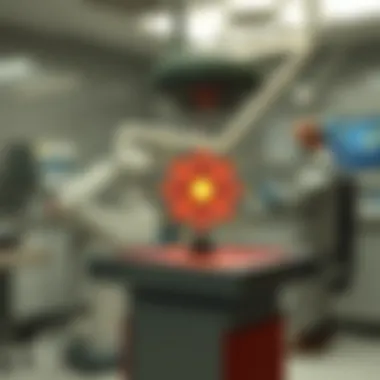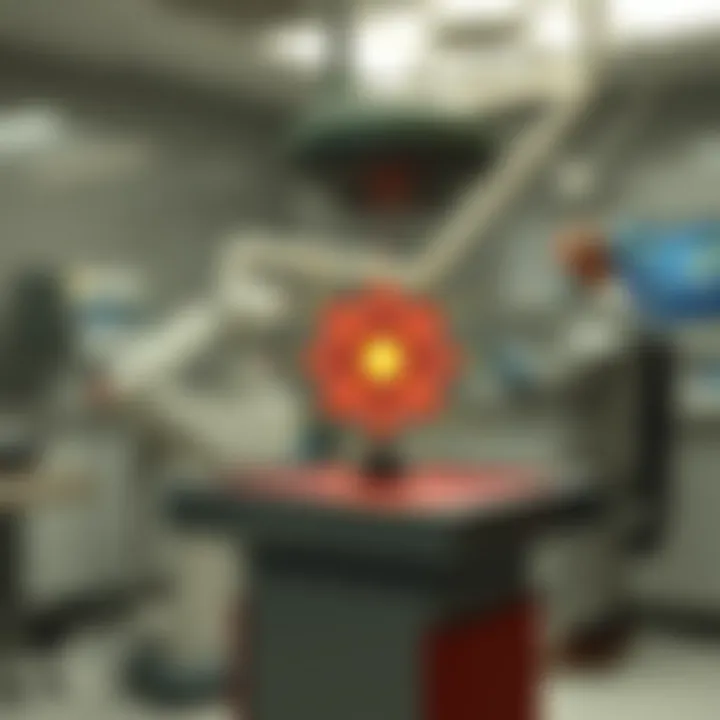Physics Innovations in Treating Cutaneous Squamous Cell Carcinoma


Intro
In the ever-evolving field of oncology, the fusion of physics with cancer treatment stands as a testament to human ingenuity and collaborative effort. This merger is particularly pronounced in the management of Cutaneous Squamous Cell Carcinoma (CSCC), a common skin cancer that can be aggressive if not managed properly. By weaving together the precision of physics with the complexity of cancer biology, we open up avenues for innovative treatment strategies and improved patient outcomes.
The integration of physics into oncological practices is not just a happy coincidence; it’s a calculated approach to tackling one of the most daunting challenges in medicine. Techniques such as radiation therapy and advanced imaging play pivotal roles, transforming the landscape of cancer treatment. As we navigate through this intersection, we will uncover how disciplines can converge to form a more holistic understanding of cancer care which ultimately enhances treatment efficacy.
Throughout this article, special emphasis will be placed on CSCC, pushing us to explore not just the technical capabilities but also the broader implications on patient health and well-being.
In a world where multidisciplinary collaboration is increasingly vital, our understanding of CSCC can grow richer, leading to synergistic advancements. This article aims to underline the significance of these dual perspectives—physics and oncology—working together to forge a future where cancer treatments are not only effective but also personalized and patient-centered.
Prelude to CSCC Oncology
A deep dive into the field of oncology reveals an intricate tapestry where various disciplines weave together. Among these, the relationship between physics and cancer treatment stands out, especially in the context of Cutaneous Squamous Cell Carcinoma (CSCC). Understanding this intersection is not just an academic exercise but a vital component in developing effective treatment methods that enhance patient outcomes. As cancer continues to challenge the medical community, embracing the principles from the realm of physics can provide groundbreaking solutions that transform how we approach therapy.
Definition and Overview of CSCC
Cutaneous Squamous Cell Carcinoma refers to a malignancy originating from the squamous cells, which are flat cells located in the outer layer of the skin. This form of skin cancer typically manifests in areas exposed to the sun, leading to a variety of symptoms ranging from raised bumps to lesions. While CSCC is generally considered less dangerous than melanoma, it is not to be underestimated; untreated cases can lead to significant morbidity and, in rare instances, mortality. The evolving understanding of carcinogenesis in skin cells, fueled by both biological and physical sciences, plays a crucial role in developing tailored treatment options.
Epidemiology and Prevalence
The occurrence of CSCC is notably on the rise globally. Factors contributing to this trend include increased sun exposure, immunosuppression, and changes in lifestyle. According to statistics, CSCC is the second most common form of skin cancer after basal cell carcinoma. In regions with high ultraviolet exposure, the incidence rates can skyrocket. For instance, a recent study indicated that among individuals with fair skin, the likelihood of developing this cancer peaks significantly in older adults, stressing the importance of early detection and effective management strategies.
"The exponential rise in CSCC cases emphasizes a pressing need for integrated treatment approaches that involve innovative technologies and fundamental physics."
Moreover, there is a marked disparity in the prevalence of CSCC based on demographics, underscoring the need for personalized approaches to treatment. Understanding who is most affected not only guides screening procedures but also informs public health initiatives aimed at prevention. Overall, the interplay between epidemiological factors and physics-based solutions presents an opportunity for researchers and clinicians to rethink traditional cancer therapies and explore new frontiers in patient care.
The Role of Physics in Oncology
The intersection of physics and oncology has become increasingly significant as it allows for the development of innovative approaches to cancer treatment, particularly in the context of Cutaneous Squamous Cell Carcinoma (CSCC). Every time a radiation beam is directed at a tumor, it’s ultimately physics working behind the scenes to ensure precision and efficacy. The role of physics in oncology is pivotal not merely for treatment but also for understanding the disease itself, the mechanisms of tumor growth, and the responses to various therapies.
In the modern landscape of cancer research, the importance of physics becomes evident when examining how it shapes the methodologies for diagnosis and treatment. The application of physics promotes a more strategic approach, elevating the standard of care for patients. Here's a closer look at some specific elements tied to the role of physics in this field:
- Precision in Treatment: Physics enables the calculation of dose distribution in radiation therapy, ensuring that malignant cells receive adequate radiation while sparing surrounding healthy tissue. This precision is crucial when dealing with CSCC, as damage to nearby structures can lead to significant complications.
- Imaging Techniques: Advanced imaging technologies, like MRI and PET scans, rely on principles of physics to visualize tumors. These techniques support early diagnosis and treatment planning.
- Interdisciplinary Collaboration: Physicists, oncologists, radiologists, and other specialists must work together to harness the power of physics effectively. This multidisciplinary approach fosters a holistic view of patient care and drives innovation in treatment modalities.
Physics not only improves the outcomes of existing treatments but also paves the way for emerging technologies that can redefine cancer therapy entirely. As we'll see next, the understanding of physics is integral to comprehending radiation therapy.
Understanding Radiation Therapy
Radiation therapy represents one of the mainstays in the treatment of CSCC, and its application is deeply rooted in the principles of physics. At its core, radiation therapy aims to eradicate cancerous cells through several mechanisms, primarily by damaging their DNA.
One of the keys to successful radiation therapy lies in the types of radiation used:
- Ionizing Radiation: This type includes X-rays and gamma rays, which have enough energy to dislodge electrons from atoms, leading to cellular damage.
- Proton Therapy: Protons deliver targeted radiation, producing a specific depth of absorption within tissues, which proves beneficial for tumors located close to vital organs.
Technological advances in radiation techniques, such as Intensity-Modulated Radiation Therapy (IMRT), have allowed oncologists to customize treatment plans, tailoring the radiation dose to the tumor's unique shape and size. This customization minimizes exposure to surrounding normal tissues with precision.
Additionally, the physical properties of radiation therapy make it an ideal candidate for adaptation alongside other treatment methods like chemotherapy and immunotherapy. The synergy created through combination therapies often results in improved patient outcomes.
"The advancement in radiation therapy is a testament to what happens when physics and oncology converge, leading to improved strategies for tackling complex malignancies like CSCC."
Innovations in Imaging Technology
In the realm of cancer diagnosis and treatment, imaging technologies have seen remarkable advancements, largely informed by physics principles. The ability to accurately visualize tumors before treatment is paramount and continuously evolving.
- Magnetic Resonance Imaging (MRI): This technology employs strong magnetic fields and radio waves to create detailed images of the body's internal structures. It is particularly useful for assessing soft tissue tumors and lymph node involvement in CSCC.
- Computed Tomography (CT): CT scans combine multiple X-ray images taken from different angles to produce cross-sectional views of the body. Physicians can evaluate the staging and size of a tumor accurately, enhancing treatment planning.
- Positron Emission Tomography (PET): This technique allows for metabolic imaging. By administering a radioactive tracer, it provides insights into cancer's metabolic activity, assisting in assessing treatment responsiveness.
- Novel Imaging Modalities: Additionally, advancements in hybrid imaging, such as PET/CT and PET/MRI, optimize both anatomical and functional imaging, giving a comprehensive view that aids in tailored treatment strategies.
The progression in imaging technology not only facilitates early detection but also minimizes the uncertainty that often accompanies treatment decisions. By combining physics with cutting-edge imaging techniques, oncologists can embark on a more targeted, personalized approach to CSCC care.


Diagnosis of CSCC
Diagnosing Cutaneous Squamous Cell Carcinoma (CSCC) is a critical undertaking that paves the way for effective treatment strategies and better patient outcomes. Early detection significantly enhances the prognosis, as timely intervention can prevent the progression of disease and reduce complications. Moreover, with the increasing incidence of skin cancers due to factors like UV exposure and immunosuppressive therapies, understanding the nuances of CSCC diagnosis is more important than ever.
Histopathological Assessment
Histopathological assessment serves as the cornerstone of cancer diagnosis. This involves examining tissue samples under a microscope to identify cancerous cells. The process usually begins when a clinician spots a suspicious lesion, which is subsequently biopsied. In the laboratory, pathologists perform a detailed analysis, looking for specific markers and cellular characteristics that are indicative of CSCC.
- Differentiation: Pathologists assess how closely the cancer cells resemble normal cells. Highly differentiated cells may suggest a slower-growing tumor, while poorly differentiated cells can indicate aggressive behavior.
- Invasion: The degree to which cancer has invaded surrounding tissues is crucial in staging the disease. This can inform the clinician about treatment options and the potential need for more aggressive interventions.
- Cellular Features: Distinctive features such as keratinization and atypical mitotic figures are noted, helping to differentiate CSCC from other types of skin cancers.
The histopathological evaluation harmonizes the subjective observations of pathologists with the objective findings, crafting a more comprehensive understanding of the tumor's nature and behavior. A reliable diagnosis can dictate the course of action, giving patients and doctors a clear plan based on the tumor's characteristics.
Role of Imaging in Early Detection
In today's fast-paced medical environment, the amalgamation of traditional diagnostic methods and advanced imaging technologies is proving invaluable in the early detection of CSCC. Imaging techniques such as dermoscopy, ultrasound, and MRI can provide insights that are not always visible to the naked eye.
- Dermoscopy: This non-invasive technique utilizes a handheld device that magnifies skin lesions, allowing dermatologists to identify features suggestive of malignancy, such as irregular pigment patterns.
- Ultrasound: This modality aids in determining the depth of tumor invasion and the existence of lymph node involvement, crucial for accurate staging.
- MRI: Although rarely used for superficial tumors, when CSCC is suspected to have deeper tissue involvement, MRI can offer highly detailed images, enabling clinicians to assess the extent of the disease.
Imaging enhances the diagnostic accuracy and allows for a fuller assessment of the tumor before treatment commences. This multidisciplinary approach supports the surgical and medical teams in tailoring interventions that are in line with the specific characteristics of the cancer presented.
"The intersection of detailed histopathological analysis and innovative imaging technologies has transformed how clinicians diagnose and treat CSCC, shaping outcomes and optimizing patient care."
The collaborative effort between pathology and imaging is fundamental in establishing a robust diagnostic framework. As the field grows, the integration of these modalities is expected to continue evolving, utilizing techniques that leverage artificial intelligence and machine learning to further enhance diagnostic precision.
Treatment Modalities for CSCC
Understanding the treatment modalities for Cutaneous Squamous Cell Carcinoma (CSCC) is paramount in addressing the complexities of patient care. These modalities encompass both surgical and non-surgical approaches, with each offering distinct benefits and considerations that impact treatment outcomes. The primary goal remains the effective management of cancer while minimizing adverse effects on the patient’s quality of life. As we dive into this section, it's crucial to recognize how each treatment option fits within a broader strategy, emphasizing patient-centered care and the integration of recent advancements in medical technology.
Surgical Interventions
Surgical interventions represent one of the cornerstones in the treatment of CSCC. These procedures are typically favored for their potential to completely remove cancerous lesions, reducing the risk of recurrence. Two widely used surgical techniques are Mohs micrographic surgery and traditional excisional surgery. Mohs surgery, in particular, allows for the meticulous removal of cancerous skin while sparing as much healthy tissue as possible.
This technique is particularly beneficial for cancers located in areas where cosmetic outcomes are paramount, such as the face and neck. The immediate feedback loop of examining removed tissues in real-time during Mohs surgery enhances the precision of excision, ultimately leading to better patient outcomes.
In contrast, traditional excisional surgery may be more suitable for larger lesions or those in less cosmetically sensitive areas. However, it carries a higher risk of leaving behind residual cancerous cells. It's a balancing act where patient preferences and clinical indications guide the decision-making process.
Non-Surgical Treatment Approaches
Non-surgical approaches to treating CSCC have gained traction, particularly for patients who are not ideal candidates for surgery or prefer less invasive options. Among these techniques, chemotherapy and targeted therapies stand out.
Chemotherapy Techniques
Chemotherapy techniques offer a systemic treatment approach, targeting rapidly dividing cancer cells throughout the body. For CSCC, topical chemotherapy agents such as 5-fluorouracil can be particularly effective. This method allows for direct application to the tumor site, minimizing systemic exposure and associated side effects.
The key characteristic of these chemotherapy techniques lies in their ability to treat precancerous lesions and superficial cancers without the need for surgical intervention, making them a popular choice for patients seeking to avoid invasive procedures. However, it’s essential to consider that while chemotherapy can shrink tumors or eliminate superficial cancerous cells, it may not be as effective for deeper or more advanced stages of malignancy. Combining chemotherapy with other treatment modalities often yields the best results.
Targeted Therapies
Targeted therapies represent a modern approach that focuses on specific molecular targets associated with CSCC. These treatments can inhibit pathways crucial for cancer cell growth, offering a more personalized treatment avenue. For instance, inhibitors like cetuximab target the epidermal growth factor receptor (EGFR) pathway that is often overactive in squamous cell carcinoma.
One of the unique features of targeted therapies is their potential to minimize side effects that are commonly associated with traditional chemotherapy. They tend to show higher specificity in attacking cancer cells, while leaving healthy cells largely untouched. However, this approach also has its limitations; not all patients respond to targeted therapies, and mutations can lead to resistance.
Ultimately, both chemotherapy techniques and targeted therapies contribute significantly to the broader goal of optimizing individual patient outcomes in CSCC treatment. Integrating these non-surgical approaches with traditional interventions enhances therapeutic flexibility and opens up new avenues for patient-tailored strategies.
In essence, the choice of treatment modalities for CSCC should be a collaborative decision made by multidisciplinary teams, taking into account clinical guidelines, patient preferences, and the unique characteristics of each tumor.
The dialogue surrounding treatment modalities for CSCC continues to evolve. Each available option plays a vital role in tailoring the best possible care plan for patients. By combining surgical and non-surgical treatments, healthcare professionals aim to achieve favorable outcomes in a manner that respects both medical advancements and individual patient needs.


Emerging Technologies in CSCC Treatment
The rapidly changing landscape of cancer treatment makes the exploration of emerging technologies in CSCC (Cutaneous Squamous Cell Carcinoma) treatment remarkably pertinent. These advancements hold the potential to not only enhance treatment efficacy but also improve patient quality of life during and after the treatment process. The intersection of physics and oncology is pivotal here, benefiting from novel methodologies that integrate advanced technology with traditional practices. As we tread through this intricate relationship, it’s crucial to recognize how these innovations can redefine therapeutic landscapes.
Advancements in Radiation Delivery
The evolution of radiation therapy remains a cornerstone in combating CSCC. With advancements in radiation delivery systems, clinicians can achieve unprecedented precision in targeting cancer cells while minimizing damage to surrounding healthy tissues. Key innovations include:
- Intensity-Modulated Radiation Therapy (IMRT): This technique allows for varying radiation doses to be precisely delivered to different areas of the tumor, optimizing the therapeutic ratio.
- Image-Guided Radiation Therapy (IGRT): This method incorporates real-time imaging during treatment, enabling adjustments to patient positioning and thus enhancing accuracy.
- Stereotactic Body Radiotherapy (SBRT): Utilizing high doses of radiation delivered in fewer sessions, SBRT is highly effective for localized cancers like CSCC, significantly shortening treatment duration for patients.
These technologies highlight the intersection of physics and medicine, with algorithms and physics principles guiding the development of highly sophisticated delivery systems. The careful calibration of radiation beams, informed by imaging data, showcases a meticulous balance between treatment potency and safety.
Nanotechnology in Cancer Therapy
Nanotechnology presents a fascinating frontier in cancer therapy, particularly its applications in CSCC. By employing materials and devices at the nanoscale, researchers are discovering new ways to enhance drug delivery and therapeutic effectiveness. Notable advancements include:
- Targeted Drug Delivery: Nanoparticles can be engineered to directly target cancer cells, improving the concentration of medicinal compounds at the tumor site while reducing systemic side effects. This targeting is akin to a sniper’s precision, hitting only the most vital targets without collateral damage.
- Photothermal Therapy: This technique utilizes nanoparticles that absorb light and convert it to heat, selectively destroying cancer cells upon exposure to specific wavelengths. It's a promising approach that merges cutting-edge physics with therapeutic intervention.
- Diagnostic Enhancements: Nanotechnology can improve imaging modalities, making it possible to visualize microscopic tumors that conventional methods might miss. Enhanced imaging also aids in real-time monitoring of therapeutic efficacy.
Thus, the incorporation of nanotechnology not only paves the way for innovative treatment methodologies but also ensures a personalized approach to CSCC management. The potential to tailor therapies to individual patient needs further solidifies its value in oncology.
In summary, emerging technologies in CSCC treatment stand as a beacon of hope, promising better outcomes through tailored and precise therapeutic strategies. The continuous fusion of physics and biological sciences is not just beneficial; it is critical for redefining cancer care.
As researchers and medical professionals delve deeper into these innovations, the future looks promising, with the prospect of translating these scientific endeavors into tangible benefits for patients and healthcare systems alike. For those interested in the forefront of cancer research, exploring advancements in these fields offers a glimpse into the evolving nature of oncological treatments that prioritize both efficacy and patient wellbeing.
Patient Care and Support
In the realm of oncology, especially concerning Cutaneous Squamous Cell Carcinoma (CSCC), the aspect of patient care and support transcends mere medical treatment. This encompasses a holistic approach that goes beyond the hospital walls, integrating emotional, psychological, and physical support systems essential for patient recovery and well-being. Effective management of CSCC does not solely rely on innovative technologies and medical interventions; it requires a synergy of numerous factors including patient education, emotional backing, and coordinated healthcare strategies.
Importance of Multidisciplinary Teams
When we talk about battling cancer, the phrase "two heads are better than one" couldn't ring truer. This adage captures the essence of multidisciplinary teams in CSCC management. A well-rounded team typically includes oncologists, surgeons, radiologists, pathologists, and support staff, each contributing their expertise to provide comprehensive care.
The beauty of such collaboration is that it integrates multiple aspects of patient care:
- Holistic Treatment Plans: Each specialist offers insights that can lead to a tailored treatment approach, ensuring that all bases are covered.
- Enhanced Communication: Regular team meetings foster stronger communication among caregivers and keep patients informed and empowered about their care journey.
- Streamlined Patient Experience: With a coordinated plan, patients encounter a smoother healthcare process, reducing anxiety and improving overall satisfaction.
"In cancer treatment, the patient is not just a case, but a whole person with unique challenges and needs."
The role of these teams cannot be underestimated, as they can significantly improve survival rates and enhance quality of life. Studies show that patient outcomes tend to be better when an interdisciplinary approach is in play, leading to faster recovery and higher rates of patient satisfaction.
Psychosocial Support for Patients
Understanding that cancer affects more than just the physical body is crucial. The psychosocial impact of a CSCC diagnosis can be profound. Patients might deal with fear, anxiety, or depression, all of which can affect their treatment outcomes. Hence, psychosocial support becomes a cornerstone of comprehensive cancer care.
Various forms of psychosocial support include:
- Counseling Services: Trained professionals can help patients navigate the emotional turmoil that often accompanies a cancer diagnosis, providing coping strategies and emotional outlets.
- Support Groups: Connecting with others in similar situations can foster a sense of community. Patients realize they are not alone, and this support can be vital for mental health.
- Educational Resources: Providing patients with knowledge about their condition can alleviate fears and uncertainties. Understanding what to expect during treatment can empower them.
Additionally, involving family and caregivers in the support process helps create a nurturing environment from which patients can draw strength. Education for families regarding the psychological implications of cancer can aid in building a solid support network, enabling patients to feel loved and understood.
Future Directions in CSCC Research
As the field of oncology continues to evolve, understanding the future directions in cutaneous squamous cell carcinoma (CSCC) research is paramount. This knowledge not only aids in formulating innovative treatment approaches but also drives the integration of emerging technologies into clinical practice. By exploring trends like artificial intelligence (AI) and genetic profiling, researchers can enhance patient outcomes, leading to more precise therapies tailored to individual needs.
The importance of investigating future directions in CSCC lies in its ability to harness advancements that push the boundaries of current treatment paradigms. Improved detection methods, personalized medicine, and innovative intervention strategies are just a few potential benefits. By focusing on these future trends, oncologists and researchers can work collaboratively to address challenges and simplify complex treatment pathways.
Potential for AI in Oncology


The integration of AI in oncology represents a front-line shift in how we approach cancer care, especially in CSCC. AI can analyze vast amounts of data, identify patterns, and predict outcomes far beyond human capabilities. For instance, machine learning algorithms can process historical patient data to better understand treatment efficacy, leading to optimized therapeutic strategies.
- Data Analysis: AI can quickly sift through patient histories and treatment outcomes to identify which therapies yielded the best responses for various demographics, enhancing personalized treatment plans.
- Imaging Enhancement: Through training on diverse imaging datasets, AI can improve diagnostic accuracy, detecting subtle changes earlier than traditional methods might allow.
- Predictive Modeling: Risk assessment algorithms can help in identifying individuals at higher likelihood of developing aggressive forms of CSCC, guiding preventive measures and monitoring strategies accordingly.
By embedding AI into oncology practices, we can pave the way for more predictive, adaptive systems that cater to patient needs dynamically.
Exploring Genetic Profiling
Genetic profiling holds tremendous promise in the realm of CSCC research. This approach focuses on understanding the genetic mutations that contribute to the development and progression of CSCC. Insights from genetic profiling can profoundly influence treatment decisions.
- Tailored Treatments: Understanding specific genetic markers enables oncologists to select therapies that are more likely to be effective for the individual patient. For example, if a genetic mutation associated with resistance to a certain treatment is identified, alternatives can be prioritized.
- Monitoring Progression: Genetic profiling can aid in monitoring disease progression or recurrence by identifying biomarkers that signal the return of cancerous cells.
- Future Research: Ongoing studies in genetic profiling can enhance our understanding of the biological mechanisms behind CSCC, leading to the discovery of new therapeutic targets.
Incorporating genetic profiling into clinical practice fosters a shift from a one-size-fits-all approach to a more nuanced, personalized strategy in managing CSCC. It lays the groundwork for developing refined treatments that could considerably improve patient outcomes.
"The future of CSCC treatment is in harnessing the power of technology to create more personalized, effective care pathways for patients."
In summary, embracing the future directions of CSCC research by prioritizing the incorporation of AI and genetic profiling will not only improve treatment efficacy but also enhance the overall patient experience. By bridging the gap between theory and practice, we can streamline both research and clinical applications in the oncology landscape.
Ethical Considerations in CSCC Treatment
Ethics in medical practice, particularly in oncology, plays a pivotal role in shaping treatment pathways and patient experiences. When it comes to Cutaneous Squamous Cell Carcinoma (CSCC), integrating ethical considerations is not simply an academic exercise; it carries significant implications for patient trust, care delivery, and treatment efficacy. With the rapid advancements in treatment technologies and methodologies, the ethical dimensions must evolve in tandem, ensuring that patient welfare remains at the forefront.
The importance of ethical considerations in CSCC treatment emphasizes various elements that guide oncologists in providing holistic care. These considerations include patient autonomy, informed consent, and equitable access to treatment options. Each of these elements is vital in fostering an environment where patients feel respected, empowered, and adequately cared for.
Patient Consent and Autonomy
Ensuring that patients provide informed consent is fundamental in the context of CSCC treatment. Patients must be made fully aware of their diagnosis, the nature of recommended treatments, potential side effects, and alternative options available. This kind of transparency establishes a foundation of trust between the patient and the healthcare provider.
Moreover, patient autonomy allows individuals to make choices that align with their personal values and preferences. For instance, some patients may opt for aggressive treatment strategies, while others may prefer more conservative approaches. Recognizing and respecting these differences is essential. It’s crucial for healthcare professionals to not only inform patients about their options but also support them in making decisions that resonate with their beliefs and lifestyle.
In practice, a dialogue is maintained where patients engage with their medical team about their treatment plans. Clear communication ensures that patients understand the implications of their choices. Additionally, physicians should also take the time to address any misconceptions and provide ongoing support throughout the treatment journey.
Equity in Treatment Access
Equity in treatment access remains a pressing concern in CSCC oncology. Disparities exist related to socioeconomic status, geographical location, and healthcare infrastructure. For instance, residents of rural areas or lower-income neighborhoods might face challenges in accessing specialized care or advanced treatment facilities.
It’s important to tackle these issues proactively, as equitable access contributes to better health outcomes. Engaging in community outreach and awareness programs can bridge gaps in knowledge and uncover resources available to underserved populations. Furthermore, integrating solutions like telemedicine can help provide consultations to those far from treatment centers, ensuring that all patients receive timely information and care plans.
"Equity in access to cancer treatment is not just a moral obligation; it's essential for the overall effectiveness of our healthcare systems and ultimately, for patient survival rates."
To further enhance equity in treatment, policymakers and healthcare providers must collaborate closely. This is not only about distributing resources but also about fostering a healthcare culture that recognizes and addresses the diverse needs of patients. Prioritizing access to CSCC treatment involves careful consideration and action at multiple levels, from institutional policies to patient engagement strategies.
End
Ending this exploration of CSCC oncology with a thoughtful conclusion is essential. It brings together all the threads from our insightful journey through the interconnections of physics and cancer treatment. CSCC, being among the prevalent skin cancers, requires a multifaceted approach for effective management. The collaborative efforts of physics and oncology offer promising advancements that may transform patient outcomes significantly.
Recap of Key Insights
Throughout this article, we've dissected various aspects of the relationship between physics and oncology, particularly concerning CSCC. Here are some pivotal insights we've gleaned:
- Innovative Techniques in Treatment: Advancements in radiation therapy and imaging technologies have enhanced our ability to diagnose and treat CSCC effectively.
- Integration of Disciplines: The synergy between physicists, oncologists, and other healthcare professionals illuminates the importance of interdisciplinary approaches in devising effective treatment plans.
- Patient-Centric Care: Delivering effective treatments is not just about the science. Understanding patient needs, preferences, and overall wellbeing plays a critical role in the therapeutic journey.
"Progress in oncology thrives where physics and medicine lend each other a helping hand."
These insights underscore the intricate interplay of knowledge and practice necessary to combat CSCC, highlighting the tailored strategies employed to meet unique patient needs.
The Importance of Ongoing Research
Research is the backbone of any medical field. In the context of CSCC and its treatment modalities intertwined with physics, ongoing research remains vital. Here's why ongoing investigation is non-negotiable:
- Evolving Technology: As we witness rapid advancements, continuous research will ensure that practitioners wield the most current knowledge and techniques.
- Understanding Cellular Mechanisms: Delving deeper into the molecular underpinnings of CSCC can open doors to novel treatment targets and combinations, potentially enhancing efficacy.
- Personalized Medicine: The push towards personalized approaches necessitates refined research into genetic profiling and individual responses to radiation or chemotherapeutic agents.
In summary, ongoing research needs to be viewed as a commitment, one that sustains hope for patients and promises more sophisticated, effective interventions in the fight against CSCC. Resolving ethical dilemmas will also be crucial to ensuring equity and trust in treatment protocols. Without research, progress stalls, making it imperative for all stakeholders in oncology to rally around this continued effort.







